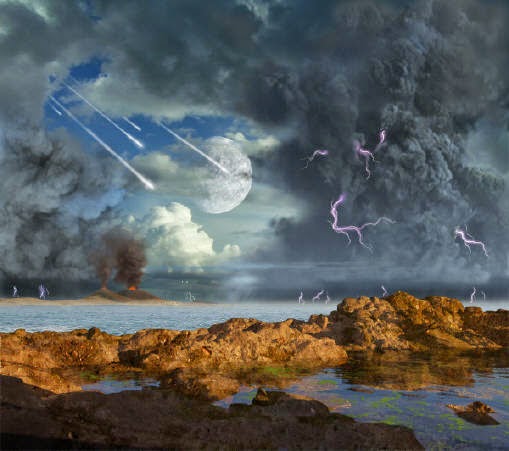The Gift of The First Plants
The first plants changed the entire history of
the earth. They made it possible for all future
life to develop. They not only changed the
face of the earth, they even changed the
atmosphere surrounding the earth.

At first, the earth's atmosphere consisted
of a mixture of gases: hydrogen, ammonia,
methane and water vapor. Later, after the great
rains, a new atmosphere came into being.
This atmosphere consisted of water vapor,
Nitrogen and Carbon Dioxide.

Living things could not emerge from the oceans
onto the land. Even if they could have breathed
this atmosphere they would probably have been
destroyed by the burning ultraviolet rays of the sun.

Carbon Dioxide, though is soluble in water.
Some of the Carbon dioxide became
dissolved in the oceans. The first plants used
this dissolved Carbon Dioxide to make their
food by photosynthesis. At the same time,
they released oxygen into the atmosphere.

Very, very gradually, the Carbon Dioxide in
the atmosphere was consumed by the plants and
then replaced by the Oxygen that was released.

Once again, a new atmosphere came into being.
This was the third atmosphere in the history of the
earth. Nearly 4/5 was Nitrogen, and nearly 1/5
was Oxygen. Only a little was Carbon Dioxide,
but it was enough for the plants.

Then another remarkable change
took place. High in the atmosphere
some of the Oxygen turned into a
special form of Oxygen called Ozone.

The Ozone acted like an invisible blanket
around the earth, preventing most of the
ultraviolet rays of the sun from reaching the
earth's surface. This is important as ultraviolet
rays are harmful to most life forms.

At last, perhaps 350 million years ago, living things
could safely come out of the oceans onto the land.
Simple plants and tiny simple animals crept
out onto the shores and began the task
of making the earth green and fertile.
Life on earth was made possible by those
first plants which developed photosynthesis.

the earth. They made it possible for all future
life to develop. They not only changed the
face of the earth, they even changed the
atmosphere surrounding the earth.
At first, the earth's atmosphere consisted
of a mixture of gases: hydrogen, ammonia,
methane and water vapor. Later, after the great
rains, a new atmosphere came into being.
This atmosphere consisted of water vapor,
Nitrogen and Carbon Dioxide.
Living things could not emerge from the oceans
onto the land. Even if they could have breathed
this atmosphere they would probably have been
destroyed by the burning ultraviolet rays of the sun.

Carbon Dioxide, though is soluble in water.
Some of the Carbon dioxide became
dissolved in the oceans. The first plants used
this dissolved Carbon Dioxide to make their
food by photosynthesis. At the same time,
they released oxygen into the atmosphere.
Very, very gradually, the Carbon Dioxide in
the atmosphere was consumed by the plants and
then replaced by the Oxygen that was released.
Once again, a new atmosphere came into being.
This was the third atmosphere in the history of the
earth. Nearly 4/5 was Nitrogen, and nearly 1/5
was Oxygen. Only a little was Carbon Dioxide,
but it was enough for the plants.
Then another remarkable change
took place. High in the atmosphere
some of the Oxygen turned into a
special form of Oxygen called Ozone.
The Ozone acted like an invisible blanket
around the earth, preventing most of the
ultraviolet rays of the sun from reaching the
earth's surface. This is important as ultraviolet
rays are harmful to most life forms.
At last, perhaps 350 million years ago, living things
could safely come out of the oceans onto the land.
Simple plants and tiny simple animals crept
out onto the shores and began the task
of making the earth green and fertile.
Life on earth was made possible by those
first plants which developed photosynthesis.
Pinegreenwoods Montessori
Montessori Biology







